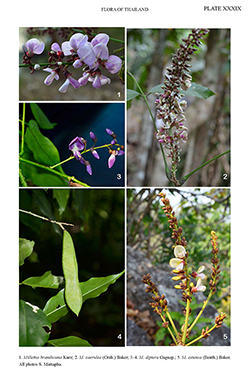e-Flora of Thailand
Volume 4 > Part 3 > Year 2020 > Page 424 > Leguminosae-Papilionoideae > Millettia
3. Millettia brandisiana Kurzwfo-0000185916
J. Asiat. Soc. Bengal, Pt. 2, Nat. Hist. 42(2): 69. 1873 & Forest. Fl. Burma 1: 355. 1877; Baker in Hook.f., Fl. Brit. India 2(4): 93. 1876; Collett & Hemsl., J. Linn. Soc. 28: 40. 1890; Dunn, J. Linn. Soc. 41: 147. 1912; Gagnep. in Lecomte, Fl. Indo-Chine 2: 375. 1916; Craib Contrib. Fl. Siam., Dicot., 1: 55. 1912 & Fl. Siam. 1(3): 387. 1928; Lock & Heald, Legumes Indo-Chine: 90. 1994; L.K.Phan & J.E.Vidal in Morat, Fl. Cambodge, Laos & Vietnam 30: 139. 2001; Mattapha et al., Thai Forest Bull., Bot., 179. 2019. Plate XXXIX: 1.
Accepted Name : This is currently accepted.
Synonyms & Citations :
Description : Tree 10–15 m tall; young twigs hairy. Stipules triangular, ca 2 mm long. Leaves: petioles 3–5 cm long, sparsely hairy; rachis 12–18 cm long. Leaflets 15–21, opposite: petiolules 2–3 mm long, hairy; lamina lanceolate to oblong, 5–7 by 2–3 cm, apex acute, base cuneate, margin entire, upper surface sparsely hairy along veins, lower surface sparsely hairy, glaucous; lateral veins 8–10 pairs; stipels setaceous 1.5–2 mm long. Inflorescences pseudoracemes or pseudopanicles 10–20 cm long, axillary, hairy. Brachyblasts present, branch-like, each bearing 2–5 flowers; bracts caducous; bracteoles lanceolate to ovate, 0.5–1 by 0.2–0.4 mm long, inserted at base of calyx tube, apex acute, margin hairy, outside subglabrous, inside glabrous; pedicels 3–4 mm long, densely hairy. Calyx tube 3–4 mm long, reddish; lobes triangular, 1.5–2 by 1.5–2 mm, apex acute, margin hairy, outside hairy, inside glabrous. Corolla pinkish; standard orbicular, 13–15 by 12–14 mm, apex retuse, base auriculate with basal callosities, margin inflexed, both sides glabrous, claw ca 1 mm long; wings oblong, 9–10 by 3–4 mm, base auriculate, apex obtuse, margin slightly undulate, both sides hairy at apex, claw 4–5 mm long; keel falcate, 7–8 by 4–4.5 mm, apex obtuse, margin entire, both sides hairy at apex, claw 4–5 mm long. Stamens diadelphous; staminal tube 9–10 mm long, glabrous; filaments 2–3 mm long; anthers oblong, ca 1.5 by 0.5 mm. Disc absent. Ovary densely hairy, 3–4 mm long, 3–5-ovuled; style 4–6 mm long, glabrous. Pods strap-shaped, laterally compressed, woody, 8–10 by 1.5–2 cm, glabrous. Seeds 2–4, orbicular, ca 2.5 by 1 cm.
Thailand : NORTHERN: Mae Hong Son (Mae Sariang), Chiang Mai (Doi Inthanon NP, Doi Suthep NP, Op Luang NP), Lamphun (Doi Khun Tan NP, Mae Li, Pa Sang), Lampang (Chae Son NP, Ngao), Phrae (Den Chai, Mae Yom NP), Uttaradit, Tak (Lan Sang NP, Mae Ping), Sukhothai (Mueang Kao), Phitsanulok (Thung Salaeng Luang NP); NORTH-EASTERN: Phetchabun (Nam Nao NP), Loei (type of Millettia venusta: Kerr 8787 -ABD BK BM K NY P TCD), Khon Kaen (Chumphae, Phu Wiang); SOUTH-WESTERN: Kanchanaburi (Mahidol Campus, Sai Yok, Sangkla Buri, Si Sawat, Thong Pha Phum), Ratchaburi; CENTRAL: Saraburi (Phu Khae), Krung Thep Maha Nakhon (Bangkok); SOUTH-EASTERN: Chon Buri (Si Racha).
Distribution : India, Myanmar (type), Laos, Vietnam.
Ecology : Mixed deciduous forests, common in open mixed dry dipterocarp forests and roadsides, 50–500 m alt. Flowering: March–April; fruiting: May–July.
Vernacular : Phi chan (พี้จั่น)(Chiang Mai); ka ton (กะท้อน)(Loei); chan (จั่น)(Kanchanaburi); chan (จั่น), kra phi chan (กระพี้จั่น)(Central).

